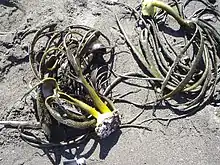| Durvillaea incurvata | |
|---|---|
 | |
| Durvillaea incurvata washed up on a beach in Chile | |
| Scientific classification | |
| Domain: | Eukaryota |
| Clade: | Diaphoretickes |
| Clade: | SAR |
| Clade: | Stramenopiles |
| Phylum: | Gyrista |
| Subphylum: | Ochrophytina |
| Class: | Phaeophyceae |
| Order: | Fucales |
| Family: | Durvillaeaceae |
| Genus: | Durvillaea |
| Species: | D. incurvata |
| Binomial name | |
| Durvillaea incurvata (Suhr) Macaya[1] | |
Durvillaea incurvata is a large, robust species of southern bull kelp endemic to Chile.
Description
Durvillaea incurvata has unbranched stipes, and many holes occur on the primary and secondary blades.[1]
Distribution
Durvillaea fenestrata is endemic to Chile from the coasts of Coquimbo to Betecoi Island in Guaitecas Archipelago.[1][2]
Human use
Along with D. antarctica, D. incurvata is used in Chilean cuisine. The Mapuche call the species kollof and in Quechua the stipes are called ulte or huilte, and the blades are cochayuyo.[1]
References
Wikimedia Commons has media related to Durvillaea incurvata.
Wikispecies has information related to Durvillaea incurvata.
- 1 2 3 4 Fraser, Ceridwen I.; Velásquez, Marcel; Nelson, Wendy A.; Macaya, Erasmo C.A.; Hay, Cameron (2019). "The biogeographic importance of buoyancy in macroalgae: a case study of the southern bull‐kelp genus Durvillaea (Phaeophyceae), including descriptions of two new species". Journal of Phycology. 56 (1): 23–36. doi:10.1111/jpy.12939. PMID 31642057.
- ↑ Fraser, C.I.; Winter, D.J.; Spencer, H.G.; Waters, J.M. (2010). "Multigene phylogeny of the southern bull-kelp genus Durvillaea (Phaeophyceae: Fucales)". Molecular Phylogenetics and Evolution. 57 (3): 1301–11. doi:10.1016/j.ympev.2010.10.011. PMID 20971197.
This article is issued from Wikipedia. The text is licensed under Creative Commons - Attribution - Sharealike. Additional terms may apply for the media files.